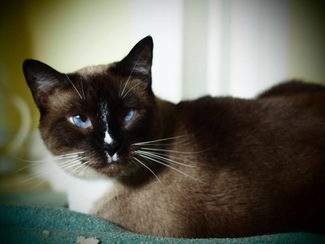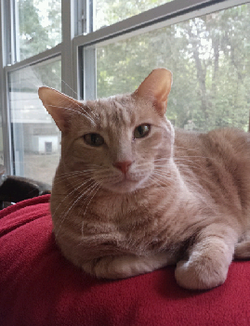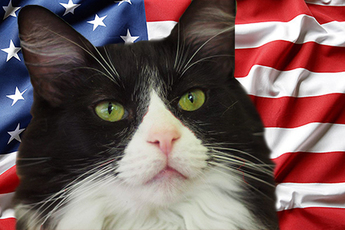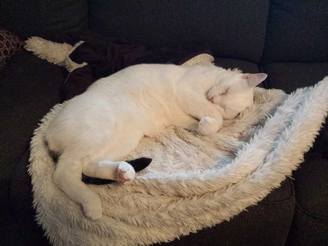
What’s in a name? Everything, especially when distinguishing a cat’s color from a coat’s design. From light to dark, betwixt and between, there’s a purr-fect fit for every feline on the palette of pussycat colors and patterns.
Coat patterns are combinations of colors in a specific layout and appear in six varieties -- solid, tabby, bicolor, tortoiseshell, tricolor and colorpoint.
Solid: The easiest to recognize, it consists of one color evenly distributed over the cat’s entire body. Although as very young kittens, some “solids” may display several hairs of a secondary color, when they mature, those hairs disappear.
Tabby: The most common pattern, it consists of spotted; striped (mackerel); ticked (agouti), and blotched (marbled).
Bicolor: This term refers to a white coat with one other color, whether a solid or a tabby pattern. Harlequin is often used to describe a cat whose coat is predominantly white. Van refers to a cat whose coat is mostly white with patches of color only on the head and tail. When a bicolor cat is mostly colored, the patches of white are named to describe their location: locket (chest), mittens (paws) and buttons (belly). A black cat with white paws, chest, and either a solid or patterned face, is aptly named a “Tuxedo”.
Tortoiseshell: This unique pattern is created by a consistent mix of orange and black or by their softer version of cream and blue, and are seen almost exclusively in females. Tortoiseshell males are rare and, in all probability, sterile. Affectionately dubbed “torties”, those cats displaying an underlying tabby pattern are often referred to as “torbies”.
Tricolor or Calico: This colorful pattern consists of white, black and red (orange) or a diluted version of cream and blue. The ratio between white and color determines the number and distribution of the two colored patches. The more white there is, the more clearly the red and black patches are defined, hence the name “calico”.
Colorpoint: Here, the face, paws and tail (point/tip) are darker than the rest of the body, and being temperature-related, the cooler parts develop a darker color. The colors of the points include dark brown (seal), red (flame), blue, and lilac, and in breeds where the points form a tricolor or tabby pattern, they’re called “lynx”.
As for coat colors, fashionable felines sport hues from white, black, red and blue to cream, brown, cinnamon and fawn.
White: The only color that is always solid with no underlying tabby markings, one genetic variety can sometimes cause deafness.
Black: While true solid black may be “the ideal”, black cats often have underlying tabby markings. When exposed to sunshine, some black coats develop a rusty tinge, whereas in the colorpoint pattern, it’s manifested as dark brown, and is referred to as seal-point.
Red: This is the professional term for orange or ginger, and because the red gene is sex-linked, red cats are usually males. And because of its strong connection to the tabby pattern, a true solid red is difficult to achieve. In the colorpoint pattern, red is referred to as flame-point.
Blue: A dilute version of black, it is, in fact, a deep bluish-gray, and can be seen in many breeds, including mixed-breed cats.
Cream: A dilute version of red, when combined with blue, it creates dilute calicos and tortoiseshells.
Brown: A rather rare color, it’s most associated with a breed called the Havana Brown, while in other breeds, brown variations may be called chocolate.
Lavender/Lilac: These are interchangeable names for a shade of pale gray-brown with pink overtones, and in the colorpoint pattern, lilac is referred to as frost-point.
Cinnamon: This is a variety of solid light brown with distinct red overtones.
Fawn: This is a dilute version of cinnamon.












 RSS Feed
RSS Feed